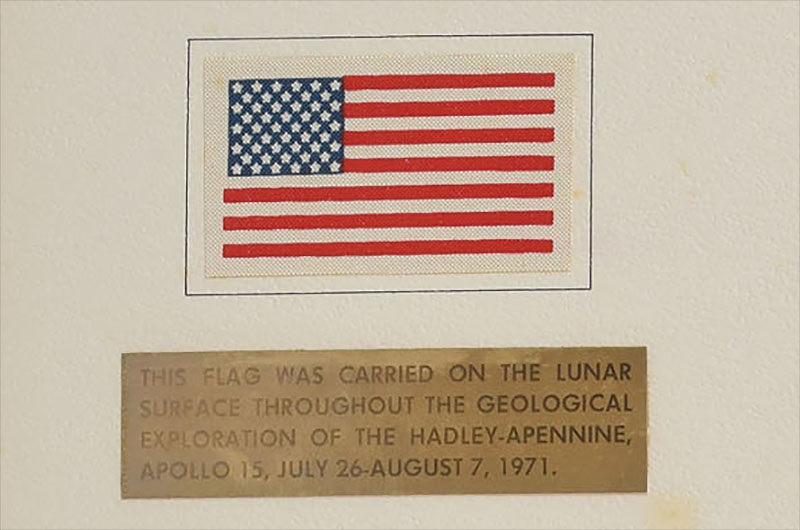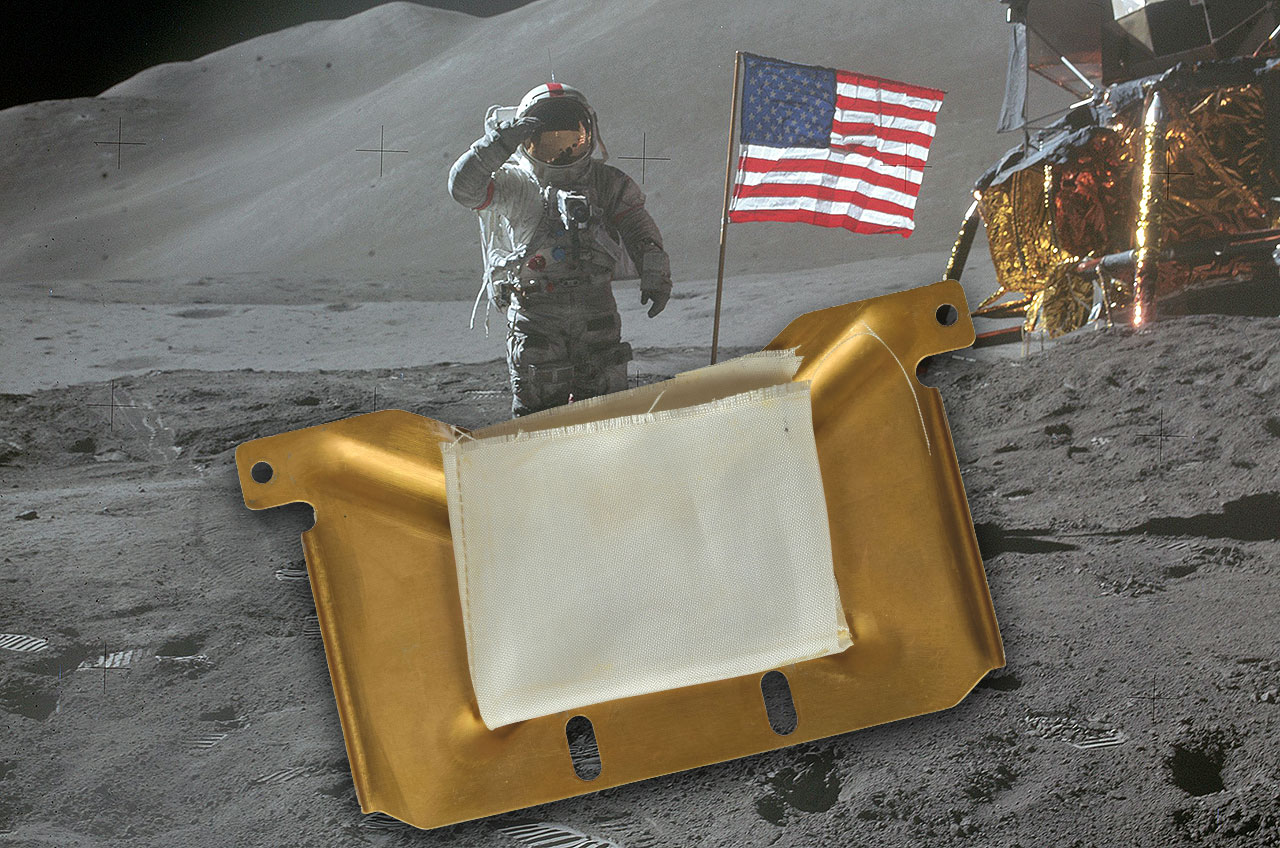Apollo Astronaut's US Flag Secretly Carried on the Moon Heads to Auction

When Apollo 15 astronaut David Scott became the seventh person to walk on the moon in 1971, he wore a spacesuit adorned with American flags on both his left shoulder and atop his life support backpack. But as an upcoming auction reveals, those were not the only two U.S. flags he had on him.
Unbeknownst to even Scott until after he returned to Earth, hidden behind the stars and stripes decorating his Portable Life Support System's Oxygen Purge System (OPS) was a pouch holding smaller U.S. flags in a secret stash.
"According to [NASA] management, a member of the JSC [Johnson Space Center, Houston] Crew Systems Division (CSD) had prepared the flags and secretly stowed them in a beta cloth package on a structural support bracket inside the OPS," wrote Scott in a letter included with the auction of one of the 2.5-by-1.5-inch (6.4 by 3.8 cm) U.S. flags and the pouch in which it flew. [Flashback: Apollo 17 Landing Site Explored By Orbiter (Video)]

"This [hidden pouch] was apparently unknown to anybody else until the OPS was disassembled after the mission by some other member of the CSD and the flag package was discovered," wrote Scott.
The identity of the original CSD member who hid the flags, or the person who found them afterward, is unknown.
Breaking space news, the latest updates on rocket launches, skywatching events and more!
The flag and the OPS support bracket with its still-attached pouch will be offered as separate lots on April 13 as part of a space and aviation themed auction hosted by RR Auction of Boston. The flag is estimated to sell for $15,000 and the OPS bracket and pouch for $30,000 or more.
Although the story behind it was not disclosed at the time, another flag, apparently from the same secret package, was sold by RR Auction in May 2014 for $27,741.35. That flag had originally been presented by Scott to his father in law, Gen. Issac "Ike" Ott, who he thanked in an inscription "for all your contributions to the success of this flight, with both airplanes and daughters."
Scott was presented with some of the flags and the 7.5 by 4 inch (19 by 10 cm) bracket as mementos of his flight by his management at the same meeting where he was told of their existence. A law passed in 2012 reaffirmed Apollo-era astronauts' title to the items they retained as souvenirs of their missions.
"I was informed that most of the flags were to be held by NASA to be distributed to individuals selected by NASA," Scott wrote in a letter accompanying the upcoming sale. "I presented some of the flags I was given to people who had made significant contributions to Apollo."
As for himself, Scott stated that he kept two of the flags, one of which he is now offering for sale.
Scott wore the OPS — and as such carried the flags — on all three of his excursions out onto the lunar surface during the Apollo 15 mission. Attached to the top of his Portable Life Support System (PLSS) backpack, the OPS was worn to supply his spacesuit with oxygen in the case of a failure in the suit or PLSS or if an emergency EVA (extravehicular activity, or spacewalk) had been needed.
In fact, Apollo 15 command module pilot Al Worden used Scott's OPS — complete with the flags still secreted inside — after Scott returned from the surface of the moon for a first-of-its-kind deep-space EVA later in the mission. During that 39-minute spacewalk, Worden retrieved film from the outside of the Apollo 15 service module.
In total, the OPS-carried flags spent more than 12 days in space, including almost 67 hours on the moon. During the 18 hours and 35 minutes they were outside on the surface, they traveled 17 miles (28 km) as Scott walked across the moon and drove the first lunar roving vehicle (LRV). [Explore the Moon (Virtually) with These Awesome Global Maps]
The hidden flags were not the only secret souvenirs on the Apollo 15 mission. Stamped envelopes, a memorial statue and timepieces were carried on the flight, and NASA later labeled them all as unauthorized. The hidden American flags were not associated with those items, though.
The same online auction offering the flag and bracket also includes a number of other items from Scott's personal collection, including Apollo 15-flown lunar surface maps, a mini LRV license plate and a personal preference kit (PPK) bag.
The auction, which will end on April 20 after seven days of bidding, includes nearly 500 items spanning the history of space exploration. Also featured are an arrow-shape decal and command module ID plate flown on Apollo 11, the first moon landing. The two artifacts, which were the mementos of an engineer who helped prepare the spacecraft before and after the mission, were recently featured in an episode of Antiques Roadshow on PBS.
For more information or to register to bid, see RR Auction’s website at: rrauction.com.
For more photos, including a diagram showing exactly where the flags were stowed inside astronaut David Scott’s spacesuit, see collectSPACE.
Follow collectSPACE.com on Facebook and on Twitter at @collectSPACE. Copyright 2016 collectSPACE.com. All rights reserved.
Join our Space Forums to keep talking space on the latest missions, night sky and more! And if you have a news tip, correction or comment, let us know at: community@space.com.

Robert Pearlman is a space historian, journalist and the founder and editor of collectSPACE.com, a daily news publication and community devoted to space history with a particular focus on how and where space exploration intersects with pop culture. Pearlman is also a contributing writer for Space.com and co-author of "Space Stations: The Art, Science, and Reality of Working in Space” published by Smithsonian Books in 2018.In 2009, he was inducted into the U.S. Space Camp Hall of Fame in Huntsville, Alabama. In 2021, he was honored by the American Astronautical Society with the Ordway Award for Sustained Excellence in Spaceflight History. In 2023, the National Space Club Florida Committee recognized Pearlman with the Kolcum News and Communications Award for excellence in telling the space story along the Space Coast and throughout the world.

